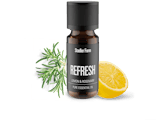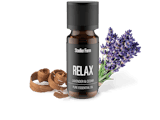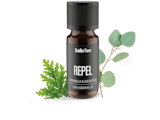What are essential oils?
Essential oils are currently enjoying great popularity. The number of products available and possible uses has increased significantly and the market is continuing to grow. Essential oils were first used by the Egyptians thousands of years ago and over time, producing them has become a true craft. Whether they are being used to remedy health complaints, improve your own well-being or simply in the kitchen, when used correctly essential oils can bring added value to everyday life. To stop you from getting lost in this jungle of aromas, we have put together a collection of information and tips as an introduction to the world of fragrances.
Definition and extraction of essential oils
Essential oils are slightly volatile mixtures that are produced from natural or synthetic (i.e. artificial) sources. In nature, essential oils also serve to keep away parasites, attract useful insects (e.g. bees for pollination) or protect against diseases (fungal or bacterial attack).
Today, the most common methods used to obtain extracts are steam distillation, extraction or the pressing of plants or their parts. These include flowers, leaves, shells, roots and seeds as well as resin, bark and wood.
During steam distillation, water is heated to approximately 100 °C. The steam produced draws the oils out of the plants and is then collected together with the oil in order to create a mixture of oil and water. After a while, the essential oils separate from the water and can then be skimmed off.
Extraction is used to produce temperature-sensitive floral fragrances. As the active ingredients would be lost during distillation, these oils are produced by means of extraction using solvents. In the process, extracts are separated from the plants using pure alcohol or mixtures of alcohol and water. Finally, the solvent is filtered out again.
With cold pressing which is only used for citrus oils, the peel of the citrus fruits is crushed after washing, mixed with water and finally centrifuged. This process separates the essential oil from the peel.
As essential oils are not greasy, they evaporate very quickly and leave no residue.
They are most commonly used in cosmetics and the perfume industry. However, essential oils are also used in medicine and even more often in naturopathy. And not least, they are extremely popular in the kitchen where they are used to spice up dishes by adding extra flavour.
Difference between natural and synthetic oils
Under the term “Natural Oils”, there are further designations for differentiating between oils in terms of their origin, the obtaining of extracts, properties and many other criteria. With these oils, all – or at least the majority – of the constituents are completely natural.
Pure (or also unadulterated) oils are obtained directly from a single plant whereas natural oils may contain several pure constituents, not just those of the eponymous plant.
Nature-identical oils are based on natural oils but are produced synthetically and are far less complex than the originals as they usually contain fewer constituents.
By contrast, synthetic oils are made in a laboratory and are completely artificial: none of the components are natural.
We recommend that only pure or natural oils are used for internal application (inhalation) or for applying to the skin.
The most commonly used plants and their effects
There are around 120 essential oils worldwide – not including mixtures – so the choice really is enormous. Because there are so many, we have chosen a few of the most popular oils to present to you below as an introduction to the world of essential oils.
Lavender – fresh, floral, herbal. Regarded as a favourite for aiding relaxation. That’s not surprising as the pleasant fragrance immediately makes you think of fields of blooms in the French region of Provence. Lavender can also help to reduce stress and relieve anxiety.
Eucalyptus – fresh, herbal, camphorous. Has a cooling effect, strengthens if you have a cold, cough or headache, helps you breathe freely. Not suitable for babies or toddlers.
Peppermint – fresh, herbal, clarifying. An extremely versatile oil. The menthol content of peppermint has an invigorating effect. So peppermint is also effective as an antioxidant and analgesic. It can also help to improve concentration and invigorate you.
Using essential oils
The most effective way to absorb essential oils is via the skin or mucous membranes, i.e. by inhaling, ingesting or rubbing them in. Therefore it is always important to handle them carefully. Even low doses are sufficient to have a beneficial effect on health. In the right dose, these oils have such a pleasant effect that if used incorrectly or in excessively high doses, undesirable side effects such as skin irritation or even allergies can occur. That is why care should be taken during use – especially in the case of babies and children for whom certain oils such as eucalyptus and thyme are not recommended. If in doubt, we recommend that you consult a doctor or pharmacist.
The best way to inhale essential oils is by using an aroma diffuser which you fill with water and then add a couple of drops of your chosen essential oil. “Less is more” applies here too. The diffuser will do the rest for you and fill your room with fragrant mist.
At Stadler Form, we specialise in aroma diffusion and have designed stylish nebulisers to enable the optimum use of essential oils. These small devices can distribute your favourite fragrance and turn any room into your own personal oasis of well-being. Besides aroma diffusers, we also offer an exclusive range of 100% natural fragrant oil mixtures which are sustainably produced and not tested on animals. Besides Refresh, Relax and Revive, from September 2020 there will be two more wonderfully fragrant oils to choose from, in the form of Recharge and Relief. So we have something to suit every taste.
And did you know that our humidifiers come with a fragrance dispenser for filling your home with your favourite fragrance?
If you have questions related to indoor room climate, please get in touch with us. Or subscribe to our newsletter to regularly get informed about current topics regarding indoor climate, experience reports or Stadler Form insights.






